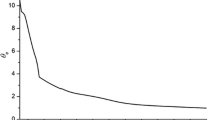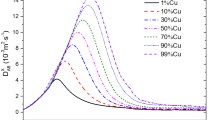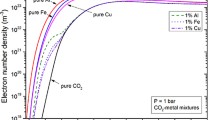Abstract
This paper presents the calculated values of equilibrium compositions, thermodynamic properties and transport coefficients (viscosity, electrical conductivity and thermal conductivity) for CO2–Cu thermal plasmas. With several copper mass proportions, the calculation is performed at temperatures 2000–30,000 K and various pressures 0.1–16 bar. Gibbs free energy minimization is used to determine species compositions and thermodynamic properties and the well-known Chapman–Enskog method is applied to calculating transport properties. Furthermore, great attention is paid to cope with the interactions between all the particles in the determination of collision integrals. The results are illustrated indicating the effect of the copper proportions and pressure on the fundamental properties of CO2–Cu thermal plasmas. It can be found that a small quantity of copper (less than 10 %) can significantly modify the charged species densities and electrical conductivity especially at low temperature. While for other properties, the influences can be noticeable only when the copper proportion is above 10 %.
















Similar content being viewed by others
References
Tanaka M, Lowke JJ (2007) Predictions of weld pool profiles using plasma physics. J Phys D Appl Phys 40:R1–R23
Franck CM, Seeger M (2006) Application of high current and current zero simulations of high-voltage circuit breakers. Contrib Plasma Phys 46(10):787–797
Swierczynski B, Gonzalez JJ, Teulet P, Freton P, Gleizes A (2004) Advances in low-voltage circuit breaker modelling. J Phys D Appl Phys 37:595–609
Nemchinsky VA, Severance R (2006) What we know and what we do not know about plasma arc cutting. J Phys D Appl Phys 39:R423–R438
Fauchais P (2004) Understanding plasma spraying. J Phys D Appl Phys 37:R86–R108
Lister GG, Lawler JE, Lapatovich WP, Godyak VA (2004) The physics of discharge lamps. Rev Mod Phys 76:541–598
Wilhelm G, Gött G, Schöpp H, Uhrlandt D (2010) Study of the welding gas influence on a controlled short-arc GMAW process by optical emission spectroscopy. J Phys D Appl Phys 43(43):434004
Schnick M, Füssel U, Hertel M, Spille-Kohoff A, Murphy AB (2010) Metal vapour causes a central minimum in arc temperature in gas–metal arc welding through increased radiative emission. J Phys D Appl Phys 43(2):022001
Liau VK, Lee BY, Song KD, Park KY (2006) The influence of contacts erosion on the SF6 arc. J Phys D Appl Phys 39(10):2114
Murphy AB (2010) The effects of metal vapour in arc welding. J Phys D Appl Phys 43(43):434001
Andanson P, Cheminat B (1979) Contamination d’un plasma d’argon par des vapeurs anodiques de cuivre. Rev Phys Appl 14(8):775–782
Cheminat B, Gadaud R, Andanson P (1987) Vaporisation d’une anode en argent dans la plasma d’un arc électrique. J Phys D Appl Phys 20(4):444–452
Adachi K, Inaba T, Amakawa T (1991) Voltage of wall-stabilized argon arc injected with iron powder. In: Proceeding 10th international symposium plasma chemistry, Bochum, Germany, 4–9 Aug 1991, 1, pp 3–10
Rong M, Ma Q, Wu Y, Xu T, Murphy AB (2009) The influence of electrode erosion on the air arc in a low-voltage circuit breaker. J Appl Phys 106(2):023308
Lee A, Herberlein JVR, Meyer TN (1985) High-current arc gap with ablative wall: dielectric recovery and wall-contact interaction. IEEE Trans Compon Hybrids Manuf Technol 8(1):129–134
Yang F, Rong M, Wu Y, Murphy AB, Pei J, Wang L, Liu Z, Liu Y (2010) Numerical analysis of the influence of splitter-plate erosion on an air arc in the quenching chamber of a low-voltage circuit breaker. J Phys D Appl Phys 43(43):434011
Abdelhakim H, Dinguirard JP, Vacquie S (1980) The influence of copper vapour on the transport coefficients in a nitrogen arc plasma. J Phys D Appl Phys 13(8):1427
Dassanayake MS, Etemadi K (1989) Thermodynamic and transport properties of an aluminum–nitrogen plasma mixture. J Appl Phys 66(11):5240–5244
Tanaka Y, Yokomizu Y, Kato M, Matsumura T, Shimizu K, Takayama S, Okada T (1997) Electrical and thermal conductivities and enthalpy of air plasma contaminated with Fe, Ca, Mg or H2O vapour. In: P Fauchais (ed) The 4th international thermal plasma processes conference, Athens, Greece, 15–18 July 1996, Begell House, New York, 1997, pp 587–594
Cressault Y, Gleizes A, Riquel G (2012) Properties of air–aluminium thermal plasmas. J Phys D Appl Phys 45:265202
Cressault Y, Hannachi R, Teulet Ph, Gleizes A, Gonnet J-P, Battandier J-Y (2008) Influence of metallic vapours on theproperties of air thermal plasmas. Plasma Sources Sci Technol 17:035016
Cressault Y, Gleizes A (2010) Calculation of diffusion coefficients in air–metal thermal plasmas. J Phys D Appl Phys 43:434006
Chervy B, Gleizes A, Razafinimanana M (1994) Thermodynamic properties and transport coefficients in SF6–Cu mixtures at temperatures of 300–30 000 K and pressures of 0.1–1MPa. J Phys D Appl Phys 27:1193
Krenek P (1992) Thermophysical properties of the reacting mixture SF6 and Cu in the range 3000 to 50 000 K and 0.1 to 2 MPa. Acta Technol CSAV 37:399–410
Wang XH, Zhong LL, Cressault Y, Gleizes A, Rong MZ (2014) Thermophysical properties of SF6–Cu mixtures at temperatures of 300–30,000 K and pressures of 0.01–1.0 MPa: part 2. Collision integrals and transport coefficients. J Phys D Appl Phys 47:495201
Rong MZ, Zhong LL, Cressault Y, Wang XH, Chen F, Zheng H (2014) Thermophysical properties of SF6–Cu mixtures at temperatures of 300–30 000 K and pressures of 0.01–1.0 MPa: part 1. Equilibrium compositions and thermodynamic properties considering condensed phases. J Phys D Appl Phys 47:495202
Zhong L, Wang X, Rong M, Wu Y, Murphy AB (2014) Calculation of combined diffusion coefficients in SF6–Cu mixtures. Phys Plasmas 21:103506
Cressault Y, Gleizes A (2004) Thermodynamic properties and transport coefficients in Ar–H2–Cu plasmas. J Phys D Appl Phys 37:560–572
Essoltani A, Proulx P, Boulos MI, Gleizes A (1994) Effect of the presence of iron vapors on the volumetric emission of Ar/Fe and Ar/Fe/H2 plasmas. Plasma Chem Plasma Process 14:301–315
Cressault Y, Murphy AB, Teulet Ph, Gleizes A, Schnick M (2013) Thermal plasma properties for Ar–Cu, Ar–Fe and Ar–Al mixtures used in welding plasmas processes: II. Transport coefficients at atmospheric pressure. J Phys D Appl Phys 46:415207
Cressault Y, Gleizes A (2013) Thermal plasma properties for Ar–Al, Ar–Fe and Ar–Cu mixtures used in welding plasmas processes: I. Net emission coefficients at atmospheric pressure. J Phys D Appl Phys 46:415206
Murphy AB, Tanaka M, Yamamoto K, Tashiro S, Sato T, Lowke JJ (2009) Modelling of thermal plasmas for arc welding: the role of the shielding gas properties and of metal vapour. J Phys D Appl Phys 42:194006
Tashiro S, Tanaka M, Nakata K, Iwao T, Koshiishi F, Suzuki K, Yamazaki K (2007) Plasma properties of helium gas tungsten arcwith metal vapour. Sci Technol Weld Join 12:202–207
Lu S, Fujii H, Nogi K (2008) Marangoni convection and weld shape variations in He–CO2 shielded gas tungsten arc welding on SUS304 stainless steel. J Mater Sci 43:4583–4591
Tanaka M, Tashiro S, Ushio M, Mita T, Murphy AB, Lowke JJ (2006) CO2-shielded arc as a high-intensity heat source. Vacuum 80:1195–1198
Hoffmann T, Baldea G, Riedel U (2009) Thermodynamics and transport properties of metal/inert-gas mixtures used for arc welding. Proc Combust Inst 32:3207–3214
Murphy AB (2013) Influence of metal vapour on arc temperatures in gas–metal arc welding: convection versus radiation. J Phys D Appl Phys 46:224004
Tanaka M, Yamamoto Y, Tashiro S, Nakata K, Yamamoto E, Yamazaki K, Suzuki K, Murphy AB, Lowke JJ (2010) Time-dependent calculations of molten pool formation and thermal plasma with metal vapour in gas tungsten arc welding. J Phys D Appl Phys 43:434009
Stoller PC, Seeger M, Iordanidis AA, Naidis GV (2013) CO2 as an Arc Interruption Medium in Gas Circuit Breakers. IEEE Trans Plasma Sci 41:2359–2369
Uchii T, Shinkai T, Suzuki K (2002) Thermal interruption capability of carbon dioxide in a puffer-type circuit breaker utilizing polymer ablation. Proc IEEE/PES Trans Distrib Conf Exhib Asia Pacific 3:1750–1754
Wada J, Ueta G, Okabe S (2013) Evaluation of breakdown characteristics of CO2 gas for non-standard lightning impulse waveforms-breakdown characteristics in the presence of bias voltages under non-uniform electric field. IEEE Trans Dielectr Electr Insul 20:112–121
Zhong LL, Yang AJ, Wang XH, Liu DX, Wu Y, Rong MZ (2014) Dielectric breakdown properties of hot SF6-CO2 mixtures at temperatures of 300–3500 K and pressures of 0.01–1.0MPa. Phys Plasmas 21:053506
Yang A, Liu Y, Sun B, Wang X, Cressault Y, Zhong L, Rong M, Wu Y, Niu C (2015) Thermodynamic properties and transport coefficients of high-temperature CO2 thermal plasmas mixed with C2F4. J Phys D Appl Phys 48:495202
LTA 72D1 CO2 high voltage circuit breaker. http://www.ABB.com/highvoltage
Murphy AB (2001) Thermal plasmas in gas mixtures. J Phys D Appl Phys 34:R151
Gleizes A, Gonzalez JJ, Freton P (2005) Thermal plasma modelling. J Phys D Appl Phys 38:R153
Wang X, Zhong L, Yan J, Yang A, Han G, Han G, Wu Y, Rong M (2015) Investigation of dielectric properties of cold C3F8 mixtures and hot C3F8 gas as Substitutes for SF6. Eur Phys J D 69(10):1–7
Chase MW, Davies CA Jr (1998) NIST–JANAF thermochemical tables, 4th edn. American Institute of Physics for the National Institute of Standards and Technology, New York
Burcat A, Ruscic B (2005) Third millennium ideal gas and condensed phase thermochemical database for combustion with updates from active thermochemical tables (Argonne National Laboratory), Report number ANL-05/20. http://www.chem.leeds.ac.uk/combustion/combustion.html
Monchick L (1959) Collision integrals for the exponential repulsive potential. Phys Fluids 2:695–700
Smith FJ, Munn RJ (1964) Automatic calculation of the transport collision integrals with tables for the morse potential. J Chem Phys 41:3560–3568
Neufeld PD, Janzen AR, Aziz RA (1972) Empirical equations to calculate 16 of the transport collision integrals (l, s)* for the Lennard Jones (12–6) potential. J Chem Phys 57:1100–1102
Rainwater JC, Holland PM, Biolsi L (1982) Binary collision dynamics and numerical evaluation of dilute gas transport properties for potentials with multiple extrema. J Chem Phys 77:434–437
Laricchiuta A, Colonna G, Bruno D, Celiberto R, Gorse C, Pirani F, Capitelli M (2007) Classical transport collision integrals for a Lennard-Jones like phenomenological model potential. Chem Phys Lett 445:133–139
NIST Computational Chemistry Comparison and Benchmark Database, NIST Standard Reference Database Number 101 Release 16a, June 2015, Editor: Russell D. Johnson III. http://cccbdb.nist.gov/
André P, Bussiere W, Rochette D (2007) Transport coefficients of Ag–SiO2 plasmas. Plasma Chem Plasma Process 27:381–403
Wang WZ, Murphy AB, Yan JD, Rong AZ, Spencer JW, Fang MTC (2012) Thermophysical properties of high-temperature reacting mixtures of carbon and water in the range 400–30,000 K and 0.1–10 atm. Part 1: equilibrium composition and thermodynamic properties. Plasma Chem Plasma Process 32:75–96
Murphy AB, Arundell CJ (1994) Transport coefficients of argon, nitrogen, oxygen, argon–nitrogen, and argon–oxygen plasmas. Plasma Chem Plasma Process 14:451–490
Copeland FBM, Crothers DSF (1997) Cross sections for resonant charge transfer between atoms and their positive ions. At Data Nucl Data Tables 65:273–288
Yevseyev AV, Radtsig AA, Smirnov BM (1982) The asymptotic theory of resonance charge exchange between diatomics. J Phys B At Mol Phys 15:4437–4452
Abdelhakim H, Dinguirard JP, Vacquie S (1980) The influence of copper vapour on the transport coefficients in a nitrogen arc plasma. J Phys D Appl Phys 13:1427
Aubreton A, Elchinger MF (2003) Transport properties in non-equilibrium argon, copper and argon–copper thermal plasmas. J Phys D Appl Phys 36:1798
Bouillon Combadiere S (1995) Etude d’un plasma d’air ensemencé de vapeurs de cuivre: propriétés de transport, diagnostiques et interaction avec des matériaux. Doctoral dissertation
Rapp D, Francis WE (1962) Charge exchange between gaseous ions and atoms. J Chem Phys 37:2631–2645
Rutherford JA, Vroom DA (1974) The reaction of atomic oxygen with several atmospheric ions. J Chem Phys 61:2514–2519
Zatsarinny O, Bartschat K (2010) Electron collisions with copper atoms: elastic scattering and electron-impact excitation of the (3 d 10 4 s) 2 S → (3 d 10 4 p) 2 P resonance transition. Phys Rev A 82:062703
Ghorui S, Das AK (2013) Collision integrals for charged–charged interaction in two-temperature non-equilibrium plasma. Phys Plasmas 20:093504
Murphy AB (2000) Transport coefficients of hydrogen and argon–hydrogen plasmas. Plasma Chem Plasma Process 20:279–297
Devoto RS (1967) Simplified expressions for the transport properties of ionized monatomic gases. Phys Fluids 10:2105–2112
Devoto RS (1967) Third approximation to the viscosity of multicomponent mixtures. Phys Fluids 10:2704–2706
Butler JN, Brokaw RS (1957) Thermal conductivity of gas mixtures in chemical equilibrium. J Chem Phys 26:1636–1643
Meador WE, Stanton LD (1965) Electrical and thermal properties of plasmas. Phys Fluids 8:1694–1703
Acknowledgments
This work was supported by National Key Basic Research Program of China (973 Program) (2015CB251002), National Natural Science Foundation of China (No. 51521065 and 51221005), China Postdoctoral Science Foundation (2015M572558) and the State Key Laboratory of Electrical Insulation and Power Equipment (No. EIPE16307).
Author information
Authors and Affiliations
Corresponding authors
Rights and permissions
About this article
Cite this article
Yang, A., Liu, Y., Zhong, L. et al. Thermodynamic Properties and Transport Coefficients of CO2–Cu Thermal Plasmas. Plasma Chem Plasma Process 36, 1141–1160 (2016). https://doi.org/10.1007/s11090-016-9709-2
Received:
Accepted:
Published:
Issue Date:
DOI: https://doi.org/10.1007/s11090-016-9709-2




